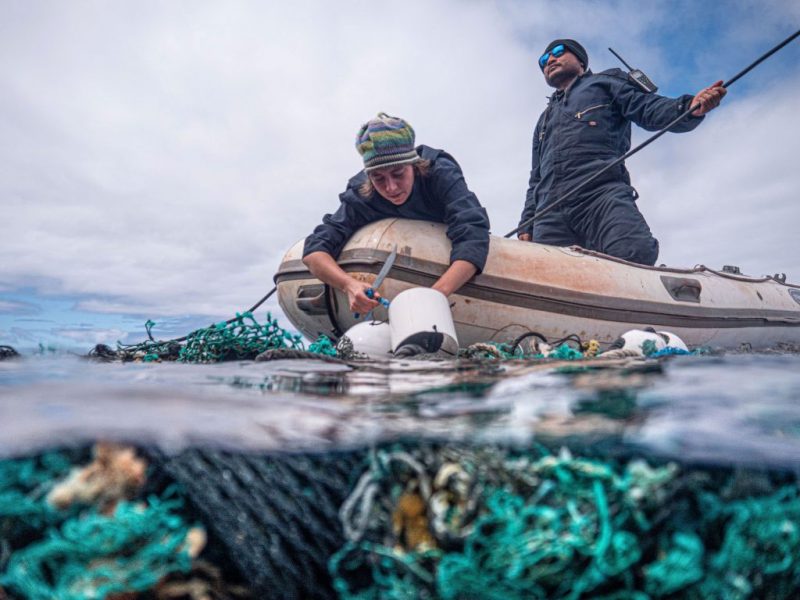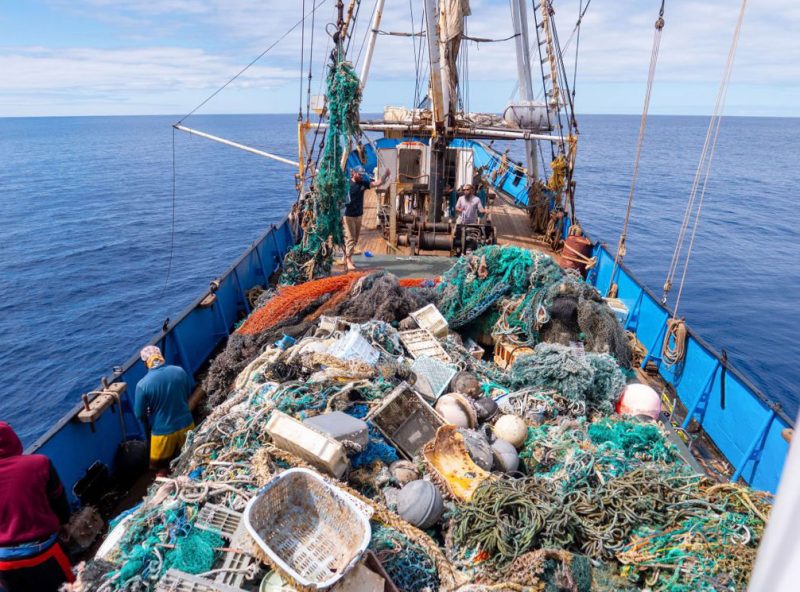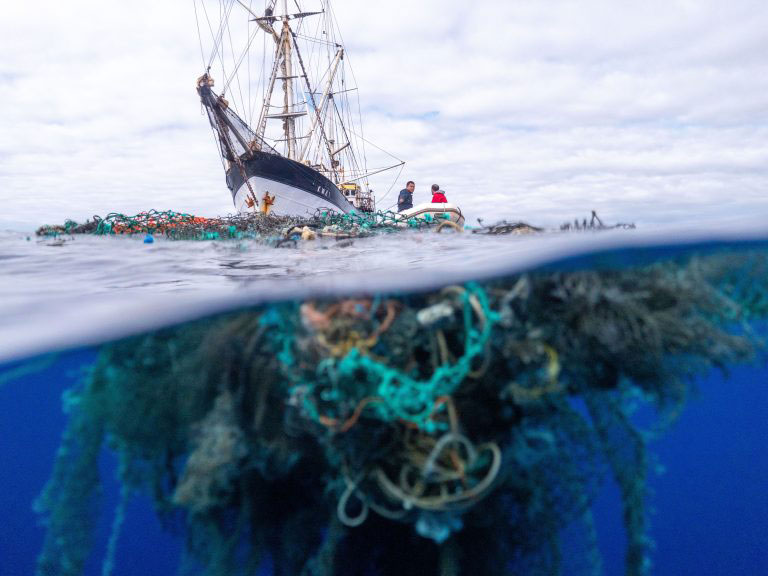
Great Pacific Garbage Patch Haul
The Honolulu-based motorsailing vessel Kwai has recently returned to port with a record-setting haul of 103 tons of marine debris collected from the Great Pacific Garbage Patch. After being chartered by the Ocean Voyages Institute of Sausalito, the Kwai departed from Hilo in early May and embarked on a 48-day voyage to the Garbage Patch to collect previously tagged ‘ghost nets’ and other marine debris. An effort spearheaded by Bay Area sailor Mary Crowley, the Ocean Voyages Institute has now chartered the Kwai on multiple missions, including a trip last year that netted some 42 tons of rubbish. Continuing to shoot for the stars, Crowley and the Ocean Voyages Institute have said that they aim to recover about 400 tons of debris from the Garbage Patch in 2020 alone.

“I am so proud of our hard-working crew,” said Ocean Voyages Institute founder and executive director Mary Crowley in a statement. “We exceeded our goal of capturing 100 tons of toxic consumer plastics and derelict ‘ghost nets,’ and in these challenging times, we are continuing to help restore the health of our ocean, which influences our own health and the health of the planet.”

The trip to the Garbage Patch is just the latest effort by the Ocean Voyages Institute, which plans to send the Kwai to the North Pacific Gyre multiple times this year. One of the great dangers of the ocean, large derelict fishing nets litter the waters and pose a major threat to marine wildlife, coral reefs and even other vessels.
Once it’s tagged with a GPS locating beacon by a volunteer vessel — oftentimes a Transpac or Pacific Cup racing vessel that is being delivered home to the West Coast — the net will continue to drift at sea until the Kwai motorsails to its position and recovers the net, or until the net washes up onto an unsuspecting coral reef and leaves a trail of destruction. Crowley and her team have noticed that once they are on scene to retrieve one net, they tend to find several others nearby.

“Our solutions are scalable, and next year, we could have three vessels operating in the North Pacific Gyre for three months, all bringing in large cargoes of debris,” says Crowley. “We are aiming to expand to other parts of the world desperately needing efficient cleanup technologies. There is no doubt in my mind that our work is making the oceans healthier for the planet and safer for marine wildlife, as these nets will never again entangle or harm a whale, dolphin, turtle or reefs.” The Kwai should be headed back to sea around the time that you read this.
The success of the Ocean Voyages Institute’s missions to the Garbage Patch is a welcome sign of relief to any sailor who has sailed through the region, or to any environmentally conscious individual who has become aware of how truly devastating the problem of marine debris and plastic pollution is. While bringing in record-setting hauls of rubbish may sound great, it’s just further evidence that record amounts of rubbish are in the oceans.
The only way to really help solve the problem is for consumers to stop consuming single-use plastics. We try to be pretty environmentally friendly at Latitude 38. We urge all our readers to do the same. Whether it’s carrying a reusable metal water bottle or a reusable travel coffee mug, or even a spare Tupperware container for extra takeout food items, we can all make small adjustments every day that will help reduce our total plastic consumption, and thus how much ends up in the ocean or in a landfill.

Was wondering if there would be a way to send a empty tanker to the North Pacific Gyre (NPG)?
The tanker would be set up and equipped to convert plastic to Oil or Diesel fuel. When the tanker
tanks are full it would return to port, empty the tanks, it would return to NPG and repeat the process.
The fuel from the waste could be used in Hawaii, or sent to the west coast. Have read there are some
models that can convert plastic back to oil or diesel. This would be a great PR project for the oil companies.
and help clean up the Oceans. The energy needed to convert the plastic to fuel could come from the use of
fuel cells. Would be happy to work on such a project.
Take a look at this photo – and all the others like it from the GPGP – and you will see that the majority of debris is from fishing and other commercial vessels. Not single-use plastics (although those add immensely to the problem of marine debris, of course). So the answer to addressing this type of ubiquitous macro plastic debris in the Pacific Gyre, alas, lies in addressing the fishing industry’s use of plastic nets and gear, as well as their Illegal dumping and abandonment of nets. Not a mission for the faint of heart. As the former Research Coordinator for Algalita Marine Research & Education, I can tell you that land-based, single-use consumer plastics have already largely broken down to micro plastic “confetti” by the time it is trapped in the Gyre. As an archaeologist who has seen Gyre plastics up close and personal, my personal opinion is that much of the small decomposing plastic debris in the Gyre is decades old and has been upwelling and recirculating in the ocean currents from the times before MARPOL IV.
Best of luck to the Kwai and Ocean Voyages-
I hope they are to expand their good work.
Is there anything that can be done to reduce the number of ghost nets? Doesn’t seem like it has anything to do with water bottles or takeout containers.
Are there certain fisheries that should be avoided, or outright boycotted?
I worked a tuna boat (super seiner) in the early eighties. The commercial fisherman care only about one thing, and that’s filling the hold with the species of fish they’re after. They change engine oil while out at sea, dumping the old oil overboard, constantly look for schools of porpoise to set nets on, because usually the tuna are swimming below the porpoise, and do nothing to help the species and kill tons of “undesirable” fish and marine life while out at sea. They’re a disgusting lot!
Hahn plastics is doing a fantastic job removing plastic debris from the oceans and processing it into plastic lumber and other big and useful recycled plastic items. Their fence lumber for instance, will outlast any wood product and saves trees at the same time. The world can mine the vast amounts of plastic waste in our oceans and make useful products from this garbage. There should be a nuclear powered super tanker sized ship cleaning up this plastic and bringing it back to a factory to be up cycled.